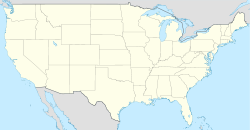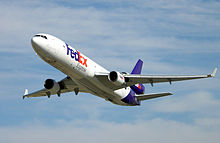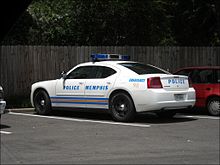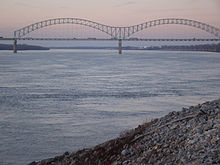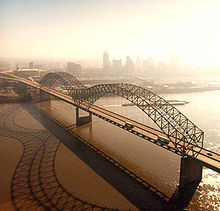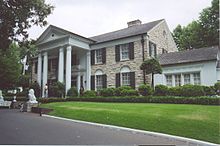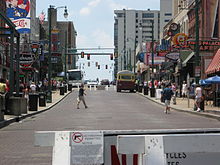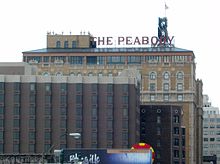- Memphis, Tennessee
-
[1] ities in the Memphis metropolitan area|Memphis metropolitan area}}
"Memphis" redirects here. For the ancient Egyptian capital, see Memphis, Egypt. For other uses, see Memphis (disambiguation).Memphis — City — Downtown Memphis & Mississippi River 
Flag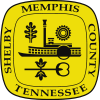
SealNickname(s): The River City, The Bluff City Location in Shelby County and the state of Tennessee Location in the United States Coordinates: 35°07′03″N 89°58′16″W / 35.1175°N 89.97111°W Country United States State Tennessee County Shelby Founded 1819 Incorporated 1826 Government - Mayor A C Wharton Area - City 313.8 sq mi (763.4 km2) - Land 302.3 sq mi (723.4 km2) - Water 15.4 sq mi (40.0 km2) Elevation 337 ft (103 m) Population (2010)[2] - City 646,889 (20th) - Density 2,140/sq mi (826.3/km2) - Metro 1,316,100 - Demonym Memphian Time zone CST (UTC-6) - Summer (DST) CDT (UTC-5) ZIP Codes 37501, 37544, 38002, 38016, 38018, 38028, 38088, 38101, 38103–38109, 38111–38120, 38122, 38124–38128, 38130–38139, 38141, 38145, 38147–38148, 38150–38152, 38157, 38159, 38161, 38163, 38166–38168, 38173–38175, 38177, 38181–38182, 38184, 38186–38188, 38190, 38193–38194, 38197 Area code(s) 901 FIPS code 47-48000[3] GNIS feature ID 1326388[4] Website www.memphistn.gov Memphis is a city in the southwestern corner of the U.S. state of Tennessee, and the county seat of Shelby County. The city is located on the 4th Chickasaw Bluff, south of the confluence of the Wolf and Mississippi rivers.
Memphis had a population of 646,889 at the 2010 census,[2] making it the largest city in the state of Tennessee, the third largest in the Southeastern United States, and the 20th largest in the United States. The greater Memphis metropolitan area, including adjacent counties in Mississippi and Arkansas, had a 2010 population of 1,316,100.[2] This makes Memphis the second largest metropolitan area in Tennessee, surpassed only by metropolitan Nashville, which has overtaken Memphis in recent years. Memphis is the youngest of Tennessee's major cities. A resident of Memphis is referred to as a Memphian, and the Memphis region is known, particularly to media outlets, as the "Mid-South".
Contents
History
Main article: History of Memphis, TennesseeEarly history
 A Mississippian era priest (Digital illustration, 2004)
A Mississippian era priest (Digital illustration, 2004)
Because it occupies a substantial bluff rising from the Mississippi River, the site of Memphis is a natural location for settlement. The area was first settled by the Mississippian Culture and then by the Chickasaw Indian tribe. For 10,000 years they occupied the bluffs along the river, building a large mound on the bluff. European exploration came later, beginning in the 16th century with Spanish explorer Hernando de Soto and French explorers led by René-Robert Cavelier, Sieur de La Salle.[5]
In 1795 the Spanish governor of Louisiana, Manuel Gayoso de Lemos, acquired land for a fort from the Chickasaw. Fort San Fernando de las Barrancas was built in the summer of 1795 on the fourth Chickasaw Bluff, just south of the Wolf River. It gave Spain control of navigation on the Mississippi River in the region until 1797 when it was abandoned in keeping with Pinckney's Treaty.[6][7] The fort was dismantled, its lumber and iron shipped away. Its ruins went unnoticed when Memphis was laid out twenty years later.[8]
The land comprising present-day Memphis remained in a largely unorganized territory throughout most of the 18th century. In 1796, the site became the westernmost point of the newly admitted state of Tennessee, located in the Southwest United States.
19th century
Memphis was founded in 1819 by John Overton, James Winchester and Andrew Jackson.[9][10] The city was named after the ancient capital of Egypt on the Nile River.[citation needed] Memphis developed as a transportation center in the 19th century because of its flood-free location, high above the Mississippi River.
As the cotton economy of the antebellum South depended on the forced labor of large numbers of African-American slaves, Memphis became a major slave market. In 1857, the Memphis and Charleston Railroad was completed, the only east-west railroad across the southern states prior to the Civil War.
Tennessee seceded from the Union in June 1861, and Memphis briefly became a Confederate stronghold. Union ironclad gunboats captured the city in the naval Battle of Memphis on June 6, 1862, and the city remained under Union control for the duration of the war. Memphis became a Union supply base and continued to prosper throughout the war. Meanwhile, Confederate General Nathan Bedford Forrest harassed Union forces in the area.
In the 1870s, a series of yellow fever epidemics devastated Memphis. The worst outbreak, in 1878, reduced the population by nearly 75% as many people died or fled the city permanently. Property tax revenues collapsed, and the city could not make payments on its municipal debts. As a result, Memphis temporarily lost its city charter and was a taxing district from 1878–1893. The city was rechartered in 1893.[11]
20th century
 Cotton merchants on Union Avenue (1937)
Cotton merchants on Union Avenue (1937)
Memphis grew into the world's largest spot cotton market and the world's largest hardwood lumber market. Into the 1950s, it was the world's largest mule market.[12]
From the 1910s to the 1950s, Memphis was a place of machine politics under the direction of E. H. "Boss" Crump. During the Crump era, Memphis developed an extensive network of parks and public works as part of the national City Beautiful movement. Determined never to suffer plagues again, it rebuilt with meticulous sanitation and drainage. However, it did not encourage heavy industry and allowed Mr. Crump's censor to ban movies.
During the 1960s, the city was at the center of civil rights issues, notably a sanitation workers' strike. The Lorraine Motel in the city was also the venue of the assassination of Martin Luther King, Jr. on April 4, 1968, the day after giving his prophetic I've Been to the Mountaintop speech at the Mason Temple.
Memphis is well known for its cultural contributions to the identity of the American South. Many renowned musicians grew up in and around Memphis and moved from the Mississippi Delta.[13] These included such musical greats as Elvis Presley, Jerry Lee Lewis, Muddy Waters, Carl Perkins, Johnny Cash, Robert Johnson, W. C. Handy, B.B. King, Howlin' Wolf, Isaac Hayes, Booker T. Jones, Al Green, Three 6 Mafia, The Sylvers, and many others.
Geography
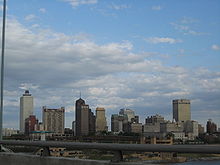 Skyline of Memphis as seen from the Hernando de Soto Bridge
Skyline of Memphis as seen from the Hernando de Soto Bridge
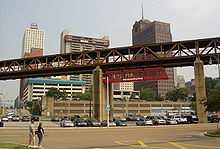 The Mud Island Monorail, in Downtown Memphis (2005)
The Mud Island Monorail, in Downtown Memphis (2005) Main article: Geography of Memphis, Tennessee
Main article: Geography of Memphis, TennesseeMemphis is located in southwestern Tennessee at 35°7′3″N 89°58′16″W / 35.1175°N 89.97111°W.[14] According to the United States Census Bureau, the city has a total area of 313.8 sq mi (813 km2), of which 302.3 sq mi (783 km2) is land and 15.4 sq mi (40 km2), or 5.24%, is water.
Cityscape
Downtown Memphis rises from a bluff along the Mississippi River, and the city sprawls outward over southwest Tennessee and into northern Mississippi and eastern Arkansas. Several large parks are scattered through the city, notably Overton Park in Midtown and the 4,500 acres (18 km2) Shelby Farms. The city is a national transportation hub and Mississippi River crossing for Interstate 40, (east-west), Interstate 55 (north-south), barge traffic, Memphis International Airport (FedEx's "SuperHub" facility) and numerous freight railroads that serve the city.
Aquifer
Shelby County is located over four natural aquifers, one of which is recognized as the "Memphis sand aquifer" or simply as the "Memphis aquifer". This artesian water is pure and soft. This particular water source, located some 350 to 1,100 feet (110 to 340 m) underground, is estimated by Memphis Light, Gas and Water to contain more than 100 trillion US gallons (380 km3) of water.[15]
Climate
Memphis has a humid subtropical climate, with four distinct seasons. Winter weather comes from the upper Great Plains or from the Gulf of Mexico, leading to drastic swings in temperature. Summer weather may come from Texas (very hot and dry) or the Gulf (hot and humid). July has an average high and low of 92.1 °F (33.4 °C) and 72.9 °F (22.7 °C), with high levels of humidity due to moisture encroaching from the Gulf of Mexico. Afternoon and evening thunderstorms are frequent during some summers, but usually brief, lasting no longer than an hour. Early autumn is pleasantly drier and mild, but can be hot until late October. Late autumn is rainy and cooler; precipitation peaks again in November and December. Winters are mild to chilly, with average January high and low temperatures of 48.6 °F (9.2 °C) and 31.3 °F (−0.4 °C). Snow occurs sporadically in winter, with an average yearly snowfall of 4.6 inches (120 mm). Ice storms are a greater danger, pulling tree limbs down on power lines.
The lowest temperature ever recorded in Memphis was −13 °F (−25 °C) on December 24, 1963,[16] and the highest temperature ever was 108 °F (42 °C) on July 13, 1980.[17]
Annual precipitation is high (54.7 inches (1,390 mm)) and is relatively evenly distributed throughout the year, though the period August through October is much drier, and peaks in March–May and November/December.
Climate data for Memphis, Tennessee (Memphis Airport) Month Jan Feb Mar Apr May Jun Jul Aug Sep Oct Nov Dec Year Record high °F (°C) 79
(26)81
(27)87
(31)94
(34)99
(37)104
(40)108
(42)107
(42)103
(39)95
(35)86
(30)81
(27)108
(42)Average high °F (°C) 48.6
(9.2)54.4
(12.4)63.3
(17.4)72.4
(22.4)80.4
(26.9)88.5
(31.4)92.1
(33.4)91.2
(32.9)85.3
(29.6)75.1
(23.9)62.1
(16.7)52.2
(11.2)72.1 Average low °F (°C) 31.3
(−0.39)35.5
(1.9)43.7
(6.5)51.9
(11.1)60.8
(16.0)68.8
(20.4)72.9
(22.7)71.2
(21.8)64.3
(17.9)52.5
(11.4)42.6
(5.9)34.5
(1.4)52.5 Record low °F (°C) −8
(−22.2)−11
(−23.9)12
(−11.1)27
(−2.8)38
(3)48
(9)52
(11)48
(9)36
(2)25
(−3.9)9
(−12.8)−13
(−25)−13
(−25)Precipitation inches (mm) 4.24
(107.7)4.31
(109.5)5.58
(141.7)5.79
(147.1)5.15
(130.8)4.30
(109.2)4.22
(107.2)3.00
(76.2)3.31
(84.1)3.31
(84.1)5.76
(146.3)5.68
(144.3)54.65
(1,388.1)Snowfall inches (cm) 2.2
(5.6)1.9
(4.8)0.3
(0.8)0
(0)0
(0)0
(0)0
(0)0
(0)0
(0)0
(0)0.1
(0.3)0.1
(0.3)4.6
(11.7)Avg. precipitation days (≥ 0.01 in) 10.3 8.8 11.1 10.0 10.3 9.0 8.5 6.9 7.7 6.9 9.4 9.7 108.6 Avg. snowy days (≥ 0.1 in) 0.7 0.6 0.1 0 0 0 0 0 0 0 0.1 0.4 1.9 Sunshine hours 167.4 175.2 213.9 255.0 300.7 321.0 325.5 306.9 252.0 244.9 174.0 151.9 2,888.4 Source: NOAA [18] HKO (sun only) [19] The Weather Channel (record temps) [20] Demographics
For historical population data, see: History of Memphis, Tennessee.
According to the 2006–2008 American Community Survey, the racial composition of Memphis was:[21]
- Black or African American: 62.6%
- White: 31.7% (Non-Hispanic Whites: 29.5%)
- Hispanic or Latino (of any race): 5.0%
- Asian: 1.7%
- Native American: 0.2%
- Native Hawaiian and Other Pacific Islander: 0.1%
- Some other race: 2.7%
- Two or more races: 1.2%
As of the census[3] of 2000, there were 650,100 people, 250,721 households, and 158,455 families residing in the city. The population density was 2,327.4 people per sq mi (898.6/km²). There were 271,552 housing units at an average density of 972.2 per sq mi (375.4/km²). The racial makeup of the city was 61.41% African American, 34.41% White, 1.46% Asian, 0.19% Native American, 0.04% Pacific Islander, 1.45% from other races, and 1.04% from two or more races. Hispanic or Latino of any race were 2.97% of the population.
The median income for a household in the city was $32,285, and the median income for a family was $37,767. Males had a median income of $31,236 versus $25,183 for females. The per capita income for the city was $17,838. About 17.2% of families and 20.6% of the population were below the poverty line, including 30.1% of those under age 18 and 15.4% of those age 65 or over.
The Memphis Metropolitan Statistical Area (MSA), the 42nd largest in the United States, has a 2010 population of 1,316,100 and includes the Tennessee counties of Shelby, Tipton, and Fayette, as well as the Mississippi counties of DeSoto, Marshall, Tate, and Tunica, and Crittenden County, Arkansas.
Religion
Asian-American tombstones in Elmwood Cemetery
Since its founding, Memphis has been home to persons of many different faiths. An 1870 map of Memphis shows religious buildings of the Baptist, Catholic, Episcopal, Methodist, Presbyterian, Congregational, and other Christian denominations and a Jewish congregation.[22] In 2009, places of worship exist for Christians, Jews, Hindus, Buddhists, and Muslims.
The international headquarters of the Church of God in Christ, the second largest Pentecostal denomination in the United States, is located in Memphis. Named after the denomination's founder, Charles Harrison Mason, Mason Temple is where Martin Luther King, Jr. gave his famous "I've Been to the Mountaintop" speech the day before he was killed. The church's Temple of Deliverance is the venue of the National Civil Rights Museum's Freedom Awards.
Bellevue Baptist Church is a Southern Baptist megachurch in Memphis that was founded in 1903. Its current membership is approximately 27,000. For many years, it was led by the late Adrian Rogers, a three-term president of the Southern Baptist Convention.
The Church of Jesus Christ of Latter-day Saints has two stakes and one temple in Memphis as well as two Family History Centers/Genealogical Libraries.
Other notable and/or large churches in Memphis include Second Presbyterian Church (EPC), Evergreen Presbyterian Church (PCUSA), Colonial Park United Methodist Church, Christ United Methodist Church, Idlewild Presbyterian Church (PCUSA), The Pentecostal Church (UPCI), Calvary Episcopal Church, and Elliston Baptist Church.
Memphis is home to two cathedrals. The Cathedral of the Immaculate Conception is the seat of the Roman Catholic Diocese of Memphis, and St. Mary's Episcopal Cathedral is the seat of the Episcopal Diocese of West Tennessee.
Memphis is home to an estimated 10,000 to 15,000 Muslims of various cultures and ethnicities.[23]
Memphis is home to Temple Israel, a Reform synagogue that has approximately 7,000 members, making it one of the largest Reform synagogues in the country. Baron Hirsch Synagogue is the largest Orthodox shul in the United States.[24]
Culture
Main article: Culture of Memphis, TennesseeCultural events
 Memphis skyline, view from Tom Lee Park (2006)
Memphis skyline, view from Tom Lee Park (2006)
One of the largest celebrations the city has is Memphis in May. The month-long series of events promotes Memphis' heritage and outreach of its people far beyond the city's borders. There are four main events, the Beale Street Music Festival, International Week, the World Championship Barbecue Cooking Contest, and the Sunset Symphony. The World Championship Barbecue Cooking Contest is the largest pork barbecue cooking contest in the world.
In April, there is an event in downtown Memphis called Africa in April Cultural Awareness Festival, or simply known as Africa in April. The festival was designed to celebrate the arts, history, culture, and diversity of the African diaspora. Africa in April is a three-day festival with vendor's markets, fashion showcases, blues showcases, and an international diversity parade.
During June, Memphis is home to the Memphis Italian Festival at Marquette Park. For over 20 years, the festival has hosted musical acts, local artisans, and Italian cooking competitions. It also presents chef demonstrations, the Coors Light Competitive Bocce Tournament, the Galtelli Cup Recreational Bocce Tournament, a volleyball tournament, and pizza tossing demonstrations.
Carnival Memphis, formerly known as the Memphis Cotton Carnival, is an annual series of parties and festivities in June that salutes various aspects of Memphis and its industries. An annual King and Queen of Carnival are secretly selected to reign over Carnival activities. The African-American community staged a parallel event known as the Cotton Makers Jubilee from 1935 to 1982, when it merged with Carnival Memphis.[25]
A market and arts festival, the Cooper-Young Festival, is held annually in September in the Cooper-Young district of Midtown Memphis. The event draws artists from all over North America and includes local music, art sales, contests, and displays.
Memphis is also home to several film festivals, the Indie Memphis Film Festival, Outflix, and the Memphis International Film and Music Festival. Indie Memphis Film Festival is in its 14th year and held November 3–6, 2011. Recognized by MovieMaker Magazine as one of 25 "Coolest Film Festivals" (2009) and one of 25 "Festivals Worth the Entry Fee" (2011), Indie Memphis offers Memphis year-round independent film programming including Global Lens international film series, IM Student Shorts student films, and an outdoor concert film series at the historic Levitt Shell. The Outflix Film Festival, also in its 14th year, takes place September 9–15 in 2011. Outflix features a full week of LGBT interested cinema, including short films, features, and documentaries. The Memphis International Film and Music Festival is held in April and is in its 11th year and takes place at Malco's Ridgeway Four.
Formerly titled the W. C. Handy Awards, the International Blues Awards are presented by the Blues Foundation (headquartered in Memphis) for Blues music achievement, with weeklong competitions and an awards banquet including a night of performance and celebration.
The arts
Memphis is the home of founders and establishers of various American music genres, including blues, gospel, rock n' roll, Buck, crunk, and "sharecropper" country music (in contrast to the "rhinestone" country sound of Nashville). Jerry Lee Lewis, Johnny Cash, Elvis Presley, Carl Perkins, Roy Orbison, Booker T. & the M.G.'s, Otis Redding, Isaac Hayes, Sam & Dave and B.B. King all got their start in Memphis in the 1950s/60s.
Beale Street is a national historical landmark, and showcases the impact Memphis has had on American blues, particularly after World War II as electric guitars took precedence. Sam Phillips' Sun Studio, the most seminal recording studio in American popular music, still stands, and is open for tours. Elvis, Johnny Cash, Jerry Lee Lewis, Carl Perkins, and Roy Orbison all made their first recordings there and were "discovered" by Phillips. Many great blues artists recorded there prior to that as well. Lastly, Stax Records created a classic 60's soul music, much grittier and horn-based than Motown. Booker T. and the M.G.'s were the label's backing band for most of the classic hits that came out of Stax, by Sam and Dave, Otis Redding, Wilson Pickett, and many more. The sound still lives on in the Blues Brothers movie, in which many of the players themselves starred.
Several notable singers are from the Memphis area, including Ruth Welting and Kallen Esperian. Justin Timberlake also grew up in the Memphis area. The Metropolitan Opera began coming to Memphis in 1906, their first road show, but in the 1990s decided to only visit larger cities.
Well-known writers from Memphis include American Civil War historian Shelby Foote. Novelist John Grisham grew up in nearby DeSoto County, Mississippi, and many of his books are set in Memphis.
Visual art
In addition to the Brooks Museum and Dixon Gallery and Gardens, Memphis plays host to two burgeoning visual art areas, one city-sanctioned, and the other organically formed.
The South Main Arts District is an arts neighborhood in south downtown. Over the past 20 years, the area has morphed from a derelict brothel and juke joint neighborhood to a gentrified, well-lit, nicely paved home of the "Trolley Night" where patrons of the arts stroll down the street witnessing fire spinners, djs playing in front of clubs, specialty shops and galleries.
Another developing arts district in Memphis is Broad Street. Broad Street (really an east-west avenue) is undergoing neighborhood revitalization by the influx of visual artists and taking up residence and studios in the area. An art professor from Rhodes College holds small openings on the first floor of his home for local students and professional artists. Odessa, another art space on Broad Street, hosts student art shows and local electronic music. Other galleries come and go for semiannual artwalks.
Outside these two areas, Memphis has non-commercial visual arts organizations and spaces, including local painter Pinkney Herbert's Marshall Arts gallery, on Marshall Ave. near Sun Studios, another arts neighborhood characterized by affordable rent.
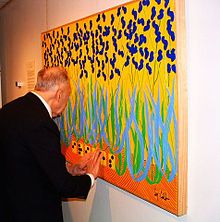 Exhibit of Guy Cobb's "Braille paintings" for the blind at Christian Brothers University in 2006
Exhibit of Guy Cobb's "Braille paintings" for the blind at Christian Brothers University in 2006
Many works of fiction and literature use Memphis as their setting, giving a diverse portrait of the city, its history, and its citizens. These include The Reivers by William Faulkner (1962), September, September by Shelby Foote (1977), The Old Forest and Other Stories by Peter Taylor (1985), the Pulitzer Prize-winning A Summons to Memphis by Peter Taylor (1986), The Firm (1991) and The Client (1994), both by John Grisham, Memphis Afternoons: a Memoir by James Conaway (1993), "Plague of Dreamers" by Steve Stern (1997) Cassina Gambrel Was Missing by William Watkins (1999), The Guardian by Beecher Smith (1999), "We are Billion-Year-Old Carbon" by Corey Mesler (2005), The Silence of the Lambs by Thomas Harris, and The Architect by James Williamson (2007).
Cultural references
Memphis is the subject of numerous pop and country songs, including "Letters to Memphis" by Pixies, "The Memphis Blues" by W. C. Handy, "Memphis, Tennessee" by Chuck Berry, "Queen of Memphis" by Confederate Railroad, "Memphis Soul Stew" by King Curtis, "Maybe It Was Memphis" by Pam Tillis, "Graceland" by Paul Simon, "Memphis Train" by Rufus Thomas, "All the Way from Memphis" by Mott the Hoople, "Wrong Side of Memphis" by Trisha Yearwood, "Walking in Memphis" by Marc Cohn, "Stuck Inside of Mobile with the Memphis Blues Again" by Bob Dylan, "Memphis Skyline" by Rufus Wainwright, and "Sequestered in Memphis" by The Hold Steady.
In addition, Memphis is mentioned in scores of other songs, including "Proud Mary" by Creedence Clearwater Revival, "Honky Tonk Women" by The Rolling Stones, "Life Is a Highway" by Tom Cochrane, "Black Velvet" by Alannah Myles, "Cities" by Talking Heads, "Crazed Country Rebel" by Hank Williams III, "Pride (In the Name of Love)" by U2, "M.E.M.P.H.I.S." by the Disco Biscuits and many others.
Economy
Main article: Economy of Memphis, TennesseeThe city's central location has led to much of its business development. Located on the Mississippi River and intersected by five major freight railroads and two Interstate highways, I-40 and I-55, Memphis is ideally located for commerce in the transportation and shipping industry. A third interstate, I-69, is under construction, and a fourth, I-22, has recently been designated from the former High Priority Corridor X. River barges are unloaded onto trucks and trains. The city is home to Memphis International Airport, the world's busiest cargo airport, which serves as the primary hub for FedEx Express shipping and was a secondary hub for Delta Air Lines after it merged with Northwest Airlines in 2008.
Memphis is the home of three Fortune 500 companies: FedEx Corporation, AutoZone Incorporated, and International Paper.[26] In addition, Memphis is home to the pharmaceutical/healthcare firm Schering-Plough Corporation, serving as the company's research and development center. In 2006, a fourth Fortune 500 company, ServiceMaster, announced it was moving its corporate headquarters from Downers Grove, Illinois, to Memphis. In 2007, ServiceMaster became a private company. Other major corporations based in Memphis include Medtronic Sofamor Danek, First Horizon National Corporation, Pinnacle Airlines, Thomas and Betts Corporation, Mueller Industries, Fred's, Verso Paper, Allenberg Cotton Co., Dunavant Enterprises, Accredo Health Group, GE Capital Aviation Services, Baptist Memorial Hospital, Methodist LeBonheur Healthcare, and Baker Donelson, among others. Corporations with major operations based in the Memphis area include Hilton Worldwide, Technicolor Home Entertainment Services, Smith & Nephew, Sharp Manufacturing, Brother International, and Caesars Entertainment Corporation.
The entertainment and film industries have discovered Memphis in recent years. Several major motion pictures have been filmed in Memphis, including Making the Grade (1984), Elvis and Me (1988), Great Balls of Fire! (1988), Heart of Dixie (1989), Mystery Train (1989), The Silence of the Lambs (1991), Trespass (1991), The Gun in Betty Lou's Handbag (1992), The Firm (1993), The Delta (1996), The People Vs. Larry Flynt (1996), The Rainmaker (1997), Cast Away (2000), 21 Grams (2002), A Painted House (2002), Black Snake Moan (2005), Forty Shades of Blue (2005), Walk the Line (2005), Hustle & Flow (2006), Nothing But the Truth (2008), Soul Men (2008), and The Grace Card (2011). The Blind Side (2009) was set in Memphis but filmed in Atlanta. The 1992 television movie Memphis, starring Memphis native Cybill Shepherd, who also served as executive producer and writer, was also filmed in Memphis. The state of Tennessee has lacked sufficient tax breaks available in other states to compete for many productions that have been interested in filming in Memphis or in the state as a whole. Besides The Blind Side, whose production was lured to Georgia, Memphis Beat, a television series on TNT set in Memphis, has been lured to Louisiana.
Law and government
Main article: Government of Memphis, TennesseeMemphis is governed by a mayor and 13 City Council members, six elected at large from throughout the city and seven elected from geographic districts. In 1995, the council adopted a new district plan which changed council positions to all districts. This plan provides for nine districts, seven with one representative each and two districts with three representatives each. The previous mayor of the city of Memphis was W. W. Herenton. He resigned from his office, effective July 30, 2009.[27] After Herenton's resignation, Myron Lowery served as Mayor Pro Tem for less than three months, one of the shortest terms in Memphis history. Former Shelby County mayor A C Wharton is the current mayor.
In recent years, there have been often rancorous discussions of the potential of a consolidation of unincorporated Shelby County and Memphis into a metropolitan government. Consolidation was a referendum item on the 2010 ballot in Memphis and Shelby County, but failed with 85% of the county voting against it.
Crime
Memphis police car (2007)
Although in 2004 violent crime in Memphis reached a record low for over a decade, that trend subsequently reversed. In 2005, Memphis was ranked the 4th most dangerous city with a population of 500,000 or higher in the U.S.[28] Crime in Memphis increased in 2005, and saw a dramatic rise in the first half of 2006. Nationally, cities follow similar trends, and crime numbers tend to be cyclical. Local experts and criminologists cite gang recruitment as one possible cause of the rise in crime in Memphis and to a reduction of 66% of federal funding to the Memphis Police Department.
In the first half of 2006, robbery of businesses increased 52.5%, robbery of individuals increased 28.5%, and homicide increased 18% over the same period of 2005. The Memphis Police Department has responded with the initiation of Operation Blue C.R.U.S.H. (Crime Reduction Using Statistical History), which targets crime hotspots and repeat offenders.[29] Memphis ended 2005 with 154 murders, and 2006 ended with 160. 2007 saw 164 murders, 2008 had 138, and 2009 had 132. Violent crimes dropped from 12,939 in 2008 to 12,047. Robbery dropped from 4,788 in 2008 to 4,137 in 2009. Aggravated assault dropped 53,870 in 2008 to 47,158 in 2009 (FBI's UCR). In 2006 and 2007, the Memphis metropolitan area ranked second most dangerous in the nation among cities with a population over 500,000. It also ranked as most dangerous in 2002 and second most dangerous in 2001.[30] In 2006, the Memphis metropolitan area ranked number one in violent crimes for major cities around the U.S according to the FBI's annual crime rankings, whereas it had ranked second in 2005.[31]
Recent statistics show a downward trend in crime in Memphis. Between 2006 and 2008, the crime rate fell by 16%, while the first half of 2009 saw a reduction in serious crime of over 10% from the previous year. The Memphis Police Department's use of the FBI National Incident Based Reporting System, which is a more detailed method of reporting crimes than that is used in many other major cities, has been cited as a reason for Memphis's frequent appearance on lists of most dangerous U.S. cities.[32]
Education
Main article: Education in Memphis, TennesseeThe city is served by Memphis City Schools, while surrounding suburbs in other areas of Shelby County are served by Shelby County Schools.
The Memphis City School System is home to over 200 elementary, middle, and high schools.
The Memphis area is home to many private, college-prep schools: Briarcrest Christian School (co-ed), Christian Brothers High School (boys), Evangelical Christian School (co-ed), First Assembly Christian School (co-ed), Hutchison School (girls), Lausanne Collegiate School (co-ed), Memphis University School (boys), Saint Benedict at Auburndale (co-ed), St. George's Independent School (co-ed), St. Agnes Academy (girls), Bishop Byrne Middle and High School (co-ed), Immaculate Conception Cathedral School (girls), and St. Mary's Episcopal School (girls). Also included in this list is Memphis Harding Academy, a co-ed school affiliated with the Churches of Christ.
Colleges and universities located in the city include the University of Memphis (a comprehensive state university), Rhodes College (formerly Southwestern at Memphis), Memphis College of Art, LeMoyne–Owen College, Christian Brothers University, Baptist College of Health Sciences (formerly Baptist Memorial Hospital School of Nursing), Memphis Theological Seminary, Harding School of Theology, Reformed Theological Seminary (satellite campus), William R. Moore College of Technology, Southern College of Optometry, Southwest Tennessee Community College, Tennessee Technology Center at Memphis, and the University of Tennessee Health Science Center (colleges of Dentistry, Medicine, Nursing, Pharmacy, Graduate Health Sciences and Allied Health Sciences). Memphis also has campuses of several for-profit post-secondary institutions, including Victory University (formerly Crichton College), Concorde Career College, ITT Technical Institute, Remington College,[33] and University of Phoenix.
The University of Tennessee College of Dentistry was founded in 1878, making it the oldest dental college in the South, and the third oldest public college of dentistry in the United States.[34]
The Christian Brothers High School Band is the oldest high school band in America, founded in 1872.[35]
Infrastructure
Transportation
Main article: Transportation of Memphis, TennesseeHighways
The Interstate Highways, Interstate 40, Interstate 55, and Interstate 240, are the main expressways in the Memphis area. Interstates 40 and 55 cross the Mississippi River at Memphis into the state of Arkansas.
The nearly-completed Interstate 22 connects Memphis with Birmingham, Alabama, via northern Mississippi (including Tupelo) and northwestern Alabama. This expressway follows the same route as U.S. Route 78. Other important federal highways though Memphis include the east-west U.S. Route 70, U.S. Route 64, and U.S. Route 72; and the north-south U.S. Route 51 and U.S. Route 61. The former is the historic highway north to Chicago via Cairo, Illinois, while the latter roughly parallels the Mississippi River for most of its course amd crosses the Mississippi Delta region to the south, with the Delta also legendary for Blues music.
The future Interstate 69 from northeast to southwest will pass through Memphis when it is completed, linking Brownsville, Texas to the already-existing portion that runs from Indianapolis, Indiana to Port Huron, Michigan. Segments of this highway are complete in DeSoto County, just south of Memphis. The segment of the I-69 Corridor running through the Memphis area is scheduled for completion in 2012.
Railroads
Three bridges over the Mississippi, view from Tom Lee Park (2007)
A large volume of railroad freight moves through Memphis, because of its two heavy-duty Mississippi River railroad crossings, which carry several major east-west railroad freight lines, and also because of the major north-south railroad lines through Memphis which connect with such major cities as Chicago, St. Louis, Indianapolis, Louisville, New Orleans, Dallas, Houston, Mobile, and Birmingham.
By the early 20th century, Memphis had two major passenger railroad stations. After passenger railroad service declined heavily through the middle of the 20th century, the Memphis Union Station was demolished in 1969. The Memphis Central Station[36] was eventually renovated, and it still serves the city.
The only inter-city passenger railroad service to Memphis for many decades has been the daily City of New Orleans train, operated by Amtrak, which has one train northbound and one train southbound each day between Chicago and New Orleans.
Airports
Memphis International Airport is the global "SuperHub" of FedEx Express, the world's largest airline in terms of freight tons flown, and has the second largest cargo operations by volume of any airport worldwide, surpassed by Hong Kong's international airport.[37] [38]
Memphis International is also a secondary hub of Delta Air Lines and had 5.054 million boarding passengers in 2009.[39] Delta operates around 138 daily flights from the airport, including a nonstop transatlantic flight to Amsterdam that operates 4 times per week.[40] Memphis International Airport has seen declining passenger and aircraft movements due to cutbacks by Delta Air Lines at the airport. Delta Air Lines has announced the closing of its Memphis pilot base in 2012. Other airlines providing passenger service are Air Canada Jazz, AirTran, American Airlines, Continental Express, SeaPort Airlines, United Airlines and US Airways.
There are also several general aviation airports in the Memphis Metropolitan Area, including the Millington Regional Jetport, located at the former Naval Air Station in Millington, Tennessee.
River port
Memphis has the second-busiest cargo port on the Mississippi River, which is also the fourth-busiest inland port in the United States.[41] The International Port of Memphis covers both the Tennessee and Arkansas sides of the Mississippi River from river mile 725 (km 1167) to mile 740 (km 1191).[42] A focal point of the river port is the industrial park on President's Island, just south of Downtown Memphis.
Bridges
Four railroad and highway bridges cross the Mississippi River at Memphis. In order of their opening years, these are the Frisco Bridge (1892, single-track rail), the Harahan Bridge (1916, a road-rail bridge until 1949, currently carries double-track rail), the Memphis-Arkansas Memorial Bridge (Highway, 1949; later incorporated into Interstate 55), and the Hernando de Soto Bridge (Interstate 40, 1973).
Utilities
Memphis's primary utility provider is the Memphis Light, Gas and Water Division (MLGW). This is the largest three-service municipal utility in the United States, providing electricity, natural gas, and pure water service to all residents of Shelby County. Prior to that, Memphis was served by two primary electric companies, which were merged into the Memphis Power Company. The City of Memphis bought the private company in 1939 to form MLGW, which was an early customer of electricity from the Tennessee Valley Authority.
MLGW still buys most of its power from TVA, and the company pumps its own fresh water from the Memphis Aquifer, using more than 180 water wells.
Health care
The Memphis and Shelby County region supports numerous hospitals, including the Methodist and Baptist Memorial health systems, two of the largest private hospitals in the country.
Methodist Le Bonheur Healthcare, the largest healthcare provider in the Mid-South, operates seven hospitals and several rural clinics. Modern Healthcare magazine ranked Methodist Healthcare[43] in the top 100 integrated healthcare networks in the United States. Methodist Healthcare operates, among others, the Le Bonheur Children's Hospital, which offers primary level 1 pediatric trauma care, as well as a nationally recognized pediatric brain tumor program.
Baptist Memorial Healthcare operates fifteen hospitals (three in Memphis), including Baptist Memorial Hospital. According to Health Care Market Guide's annual studies, Mid-Southerners have named Baptist Memorial their "preferred hospital choice for quality".
The St. Jude Children's Research Hospital, leading pediatric treatment and research facility focused on children's catastrophic diseases, resides in Memphis. The institution was conceived and built by the late entertainer Danny Thomas in 1962 as a tribute to St. Jude Thaddeus, patron saint of impossible, hopeless, and difficult causes.
Memphis is also home to the Regional Medical Center at Memphis,[44] which is locally referred to as "The Med". In recent years, the hospital has experienced severe funding difficulties that nearly led to a reduction or elimination of emergency room services. In July 2010, The Med received approximately $40.6 million in federal and local funding to keep the Elvis Presley Trauma Center operational.
Memphis is home to Delta Medical Center of Memphis,[45] which is the only employee-owned medical facility in North America.
Tourism and recreation
Main article: Tourism in Memphis, TennesseeMuseums and art collections
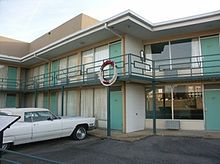 Lorraine Motel in Memphis (2005)
Lorraine Motel in Memphis (2005)
 Memphis Brooks Museum of Art in Memphis (2008)
Memphis Brooks Museum of Art in Memphis (2008)
 Mud Island Mississippi River Park (2006)
Mud Island Mississippi River Park (2006)
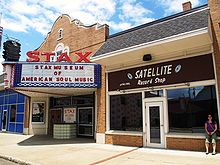 Stax Museum and Satellite Record Shop
Stax Museum and Satellite Record Shop
 Media related to Museums in Memphis, Tennessee at Wikimedia Commons
Media related to Museums in Memphis, Tennessee at Wikimedia CommonsMany museums of interest are located in Memphis.
National Civil Rights Museum
The National Civil Rights Museum is located in the former Lorraine Motel where Martin Luther King, Jr. was assassinated. It includes a historical overview of the American civil rights movement.Brooks Museum of Art
The Memphis Brooks Museum of Art, founded in 1916, is the oldest and largest fine art museum in the state of Tennessee.[1] The Brooks' permanent collection includes works from the Italian Renaissance and Baroque eras to British, French Impressionists, and 20th-century artists.Children's Museum of Memphis
The Children's Museum of Memphis exhibits interactive and educational activities for children to take part in, including a skyscraper maze, an airplane cockpit (donated by FedEx), a fire engine, an art studio, grocery store, and, most recently, a mechanic's garage sponsored by AutoZone, Inc.Graceland
Graceland, the former home of music legend Elvis Presley, is one of the most visited houses in the United States (second only to the White House), attracting over 600,000 domestic and international visitors a year. Featured at Graceland are two of Presley's private airplanes, his extensive automobile and motorcycle collection and other Elvis memorabilia. On November 7, 1991, Graceland was listed in the National Register of Historic Places.[46]Pink Palace
The Pink Palace Museum serves as the Mid-South's major science and historical museum, and features exhibits ranging from archeology to chemistry. It includes the third largest planetarium in the United States and an IMAX theater. One exhibit features a replica of the original Piggly Wiggly store, the first self-service grocery store, commemorating the invention of the supermarket by Memphian Clarence Saunders in 1916.Memphis Walk of Fame
The Memphis Walk of Fame is a public exhibit located in the Beale Street historic district, which is modeled after the Hollywood Walk of Fame, but is designated exclusively for Memphis musicians, singers, writers, and composers. Honorees include W. C. Handy, B.B. King, Bobby Blue Bland, and Alberta Hunter, among others.Mud Island River Park
Mud Island River Park and Mississippi River Museum is located on Mud Island in downtown Memphis. The park is noted for its River Walk, a 2112:1 scale working model showing 1,000 miles (1,600 km) of the Lower Mississippi River, from Cairo, Illinois to New Orleans, Louisiana and the Gulf of Mexico. 30 inches (76 cm) in the model equal 1 mile (1.6 km) of the Mississippi River. The Walk stretches roughly 0.5 miles (800 m), allowing visitors to walk in the water and see models of cities and bridges along the way.Victorian Village
Victorian Village is a historic district of Memphis featuring a series of fine Victorian-era mansions, some of which are open to the public as museums.Cotton Museum
The Cotton Museum is a museum that opened in March 2006 on the old trading floor of the Memphis Cotton Exchange at 65 Union Avenue in downtown Memphis.Stax Museum
The Stax Museum is a museum located at 926 McLemore Avenue, the former location of Stax Records. The original building, a converted movie theatre where artists such as Otis Redding, Isaac Hayes, Booker T. & the M.G.'s, Sam & Dave and many others recorded throughout the 60's and 70's, was torn down, but the original front was reconstructed on the original property. It is operated by Soulsville USA, which also operates the adjacent Stax Music Academy. The original Satellite Record Shop was also reconstructed beside it. It is the only museum in the United States to be devoted entirely to soul music.Chucalissa Indian Village
Chucalissa Indian Village is a Walls Phase mound and plaza complex that was occupied, abandoned and reoccupied several times throughout its history, spanning from 1000 to 1550 CE. Civilian Conservation Corps workers discovered Native American artifacts on the site in 1938 and archaeological excavations of this Mississippian mound complex were initiated. The facility has been operated by the University of Memphis since 1962. In 1973 Chucalissa Indian Village was added to the National Register of Historic Places. Later, in 1994, it was declared a National Historic Landmark. It is the site of the Southeast Indian Heritage Festival held annually in October.Parks
 Media related to Parks in Memphis, Tennessee at Wikimedia Commons
Media related to Parks in Memphis, Tennessee at Wikimedia Commons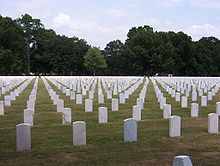 Memphis National Cemetery (2006)
Memphis National Cemetery (2006)
Major Memphis parks include W.C. Handy Park, Tom Lee Park, Audubon Park, Overton Park including the Old Forest Arboretum, the Lichterman Nature Center (a nature learning center), and the Memphis Botanic Garden.[47]
Shelby Farms park, located at the eastern edge of the city, is one of the largest urban parks in the United States.
Cemeteries
 Media related to Cemeteries in Memphis, Tennessee at Wikimedia Commons
Media related to Cemeteries in Memphis, Tennessee at Wikimedia CommonsThe Memphis National Cemetery is a United States National Cemetery located in north Memphis.
Historic Elmwood Cemetery is one of the oldest rural garden cemeteries in the South, and contains the Carlisle S. Page Arboretum. Memorial Park Cemetery is noted for its sculptures by Mexican artist Dionicio Rodriguez.
Elvis Presley was originally buried in Forest Hill Cemetery, the resting place of his backing band's bassist, Bill Black, but after an attempted grave robbing, his body was moved to the grounds of Graceland.
Other points of interest
Main article: Geography of Memphis, TennesseeBeale Street (2010) Peabody Hotel (2010)
Peabody Hotel (2010)
Beale Street
Blues fans can visit Beale Street, which used to be the center of the Black community, where a young B.B. King used to play his guitar. He occasionally appears there at the club bearing his name, which he partially owns. Street performers play live music, and bars and clubs feature live entertainment until dawn.Memphis Zoo
The Memphis Zoo, which is located in midtown Memphis, features many exhibits of mammals, birds, fish, and amphibians from all over the world. The zoo's giant panda exhibit is one of only five in North America. The Memphis Zoo is one of few that have successfully resulted in live births of rhinoceros in captivity.Peabody Hotel
The Peabody Hotel is well-known for the "Peabody Ducks" that live on the hotel rooftop, making the journey to the hotel lobby in a daily "March of Ducks" ritual.Sun Studio
Sun Studio is available for tour, which is where Elvis Presley first recorded "My Happiness" and "That's When Your Heartaches Begin". Other famous musicians who got their start at Sun include Johnny Cash, Rufus Thomas, Charlie Rich, Howlin' Wolf, Roy Orbison, Carl Perkins, and Jerry Lee Lewis. It now contains a museum as well as the still-functioning and operating studio.The Orpheum Theatre
The Orpheum Theatre was built in 1928 upon the former property of the Grand Opera House, which was burnt to the ground in 1923 during a strip tease performance by Blossom Seeley. After vaudeville's popularity waned, the building was purchased by the Malco theater chain in 1940 and presented first-run movies until Malco sold the building in 1976. The Orpheum is now managed by the Memphis Development Foundation and presents 10 to 12 Broadway shows each year. The theatre is also home to two of Memphis' local arts groups, Ballet Memphis and Opera Memphis.The New Daisy Theater
The New Daisy Theater is an all-ages concert venue located on Beale Street. After 11 pm, only those at least 18 years of age are allowed on Beale—unless they are going to (or from) a destination point like the New Daisy. The New Daisy routinely presents some of the biggest acts to come to the Mid South. Possibly the most popular venue in Memphis, past acts have included Ani DiFranco, AFI, Cannibal Corpse, GWAR, Insane Clown Posse, Keller Williams, Lamb of God, Led Zeppelin, The Doors, and Black Sabbath among many others. The venue also, on occasion, hosts the Gorilla Production Battle of the Bands as well as Mixed Martial Arts fights.Mud Island Amphitheater
Located on Front Avenue, the Mud Island Amphitheater is a concert venue with an approximate capacity of 5,000 viewers. As one of the two major concert venues in Memphis, past acts have included the likes of R.E.M., Phish, 311, The Black Crowes, Fall Out Boy, Journey, New Kids on the Block, O.A.R., Pat Benatar, Smashing Pumpkins, Steely Dan, and Willie Nelson.The Pyramid
The Pyramid Arena is a former athletic and music venue. It is one of the first sights seen when entering the city from West Memphis via the Memphis-Arkansas Memorial Bridge. The facility was built in 1991 and was originally owned and operated jointly by the city of Memphis and Shelby County. Its unique structure plays on the city's namesake in Egypt, known for its ancient pyramids. At 321 feet (98 m), it is the sixth-largest pyramid in the world behind the Great Pyramid of Giza 139 m (456 ft), Khafre's Pyramid 136 m (446 ft), the Luxor Hotel 348 ft (106 m), the Red Pyramid 104 m (341 ft) and the Bent Pyramid 101 m (331 ft). As a music venue, it was the largest in Memphis, presenting such acts as R.E.M., Phish, Aerosmith, Janet Jackson, The Rolling Stones, Bob Dylan, The Doobie Brothers, and Lynyrd Skynyrd. Bob Seger & The Silver Bullet Band is reputed[by whom?] to be the last concert ever held in The Pyramid.It has been host to the University of Memphis NCAA basketball team, the Memphis Grizzlies NBA team, the Great Midwest Conference basketball tournament, the Southeastern Conference basketball tournament, the Conference USA basketball tournaments, and the 2003 Conference USA women's basketball tournament. It has also hosted first and second rounds of the NCAA Tournament and a pay-per-view event by the WWF. The Pyramid was the venue of the boxing match between Lennox Lewis and Mike Tyson in 2002.
In 2008, the City of Memphis began leasing The Pyramid to Bass Pro Shops; the facility is to become Bass Pro's largest superstore in the country with a projected grand opening by August 2013.
Other
Other Memphis attractions include the Liberty Bowl Memorial Stadium, the FedExForum, and Mississippi riverboat day cruises.Sports
Main article: Sports in Memphis, TennesseePyramid Arena (2006)
The University of Memphis college basketball team, the Memphis Tigers, has a strong following in the city due to its recent competitive success. The Tigers finished 2nd to the Kansas Jayhawks in the 2008 NCAA Men's Division I Basketball Championship. However, in 2009, an NCAA investigation revealed that Derrick Rose's SAT scores had been invalidated, making him retroactively ineligible to play for Memphis. As a result, the NCAA vacated Memphis' entire 2007–08 season, including the tournament appearance, and forced the University to repay all tournament revenues. Head Coach John Calipari, having already left Memphis to coach for the University of Kentucky, was not reprimanded by the NCAA. The current coach of the Memphis Tigers is Josh Pastner, who coached the Tigers to an NCAA appearance in the 2010–2011 season.
The Memphis Grizzlies of the National Basketball Association is the only club from one of the "big four" major sports leagues in the city; however, the minor leagues are well represented. The Memphis Redbirds of the Pacific Coast League is a Class AAA baseball farm team for the St. Louis Cardinals. The Mississippi RiverKings, formerly the Memphis RiverKings, is a professional hockey team of the Central Hockey League "Class AA" which plays its home games in DeSoto County.
Memphis is home to Liberty Bowl Memorial Stadium, the site of University of Memphis football, the Liberty Bowl and the Southern Heritage Classic. The annual St. Jude Classic, a regular part of the PGA Tour, is also held in the city. Each February the city hosts the Regions Morgan Keegan Championships and the Cellular South Cup, which are men's ATP World Tour 500 series and WTA events, respectively.
Memphis has a significant history in pro wrestling. Jerry "The King" Lawler is the sport's greatest name to come out of the city. Sputnik Monroe, a wrestler of the 1950s, like Lawler, promoted racial integration in the city. Ric Flair also noted Memphis as his birthplace.
Memphis has been represented by several now-defunct professional sports franchises, including the Memphis Pharaohs of Arena Football, the Memphis Maniax of the XFL, the Memphis Xplorers of the AF2, the Memphis Showboats of the USFL, the Memphis Southmen of the WFL, the Memphis Houn'Dawgs of the ABA, the Memphis Sounds of the original ABA in the late 1960s and early 1970s, and the Memphis Mad Dogs of the CFL.
In the 1970s and early 1980s, the former WFL franchise Memphis Southmen / Memphis Grizzlies sued the NFL in an attempt to be accepted as an expansion franchise. In 1993, the Memphis Hound Dogs was a proposed NFL expansion that was passed over in favor of the Jacksonville Jaguars and Carolina Panthers. Memphis also served as the temporary home of the former Tennessee Oilers while the city of Nashville worked out stadium issues.
See also
- 1865 Memphis earthquake
- List of mayors of Memphis, Tennessee
- List of neighborhoods in Memphis, Tennessee
- List of people from Memphis, Tennessee
- Memphis Mafia
References
- ^ a b "Memphis Brooks Museum of Art". Brooksmuseum.org. http://www.brooksmuseum.org. Retrieved 2011-11-19.
- ^ a b c "Race, Hispanic or Latino, Age, and Housing Occupancy: 2010 Census Redistricting Data (Public Law 94-171) Summary File (QT-PL), Memphis city, Tennessee". U.S. Census Bureau, American FactFinder 2. http://factfinder2.census.gov. Retrieved August 16, 2011.
- ^ a b "American FactFinder". United States Census Bureau. http://factfinder.census.gov. Retrieved 2008-01-31.
- ^ "US Board on Geographic Names". United States Geological Survey. 2007-10-25. http://geonames.usgs.gov. Retrieved 2008-01-31.
- ^ "Tennessee Encyclopedia of History and Culture – Fort Prudhomme and La Salle". Tennesseeencyclopedia.net. http://tennesseeencyclopedia.net/entry.php?rec=495. Retrieved July 2, 2010.
- ^ Hudson, Charles M. (December 2007). Four Centuries of Southern Indians. University of Georgia Press. p. 71. ISBN 9780820331324. http://books.google.com/books?id=UcY20I7XXMAC&pg=PA71. Retrieved March 25, 2011.
- ^ Weeks, Charles A. (2010). "From Nogales to San Fernando de las Barrancas". Paths to a Middle Ground: The Diplomacy of Natchez, Boukfouka, Nogales, and San Fernando de Las Barrancas, 1791–1795. University of Alabama Press. pp. 126–141. ISBN 9780817356453. http://books.google.com/books?id=aQ6UTJ_F8F8C&pg=PA3. Retrieved March 25, 2011.
- ^ Patrick, James (March 1990). Architecture in Tennessee, 1768–1897. Univ. of Tennessee Press. p. 77. ISBN 9780870496318. http://books.google.com/books?id=JOIMXAKnCfAC&pg=PA77. Retrieved March 25, 2011.
- ^ "TN Encyclopedia: John Overton". The Tennessee Encyclopedia of History and Culture. http://tennesseeencyclopedia.net/entry.php?rec=1029. Retrieved October 24, 2008.
- ^ "Memphis History and Facts". Memphis Public Library. http://www.memphislibrary.lib.tn.us/history/memphis2.htm. Retrieved October 24, 2008.
- ^ Adams, James Truslow and Ketz, Louise Bilebof. Dictionary of American history Scribner, 1976, p. 302.
- ^ "City of Memphis Website – History of Memphis". Cityofmemphis.org. April 4, 1968. http://www.cityofmemphis.org/framework.aspx?page=296. Retrieved July 2, 2010.
- ^ Peter Guralnick. New York Times, August 11, 2007.
- ^ "US Gazetteer files: 2010, 2000, and 1990". United States Census Bureau. 2011-02-12. http://www.census.gov/geo/www/gazetteer/gazette.html. Retrieved 2011-04-23.
- ^ "Memphis Light, Gas, and Water Website – About Our Services". Mlgw.com. http://mlgw.com/SubView.php?key=about_ourutilservices. Retrieved July 2, 2010.
- ^ "Daily Averages for Memphis International Airport". weather.com. 2007-01-17. http://www.weather.com/outlook/travel/vacationplanner/wxclimatology/daily/MEM:9?climoMonth=12. Retrieved 2011-11-19.
- ^ "Daily Averages for Memphis International Airport". weather.com. 2007-01-17. http://www.weather.com/outlook/travel/vacationplanner/wxclimatology/daily/MEM:9?climoMonth=7. Retrieved 2011-11-19.
- ^ "NCDC: U.S. Climate Normals". National Oceanic and Atmospheric Administration. http://cdo.ncdc.noaa.gov/climatenormals/clim20/tn/405954.pdf. Retrieved 2010-04-26.
- ^ "Climatological Normals of Memphis". Hong Kong Observatory. http://www.hko.gov.hk/wxinfo/climat/world/eng/n_america/us/memphis_e.htm. Retrieved 2010-05-13.
- ^ "Monthly Averages for Memphis International Airport". The Weather Channel. http://www.weather.com/outlook/travel/vacationplanner/wxclimatology/monthly/MEM:9. Retrieved 2011-10-09.
- ^ American FactFinder, United States Census Bureau. "Memphis city, Tennessee – ACS Demographic and Housing Estimates: 2006–2008". Factfinder.census.gov. http://factfinder.census.gov/servlet/ADPTable?_bm=y&-geo_id=16000US4748000&-qr_name=ACS_2008_3YR_G00_DP3YR5&-ds_name=ACS_2008_3YR_G00_&-_lang=en&-redoLog=false&-_sse=on. Retrieved July 2, 2010.
- ^ "Bird's eye view of the city of Memphis, Tennessee 1870". Hdl.loc.gov. http://hdl.loc.gov/loc.gmd/g3964m.pm009010. Retrieved July 2, 2010.
- ^ Melvin, Lindsay. "Muslims in Memphis: Diversity in the mosque". Commercialappeal.com. http://www.commercialappeal.com/news/2008/sep/06/muslims-in-memphis-diversity-in-the-mosque/. Retrieved July 2, 2010.
- ^ "History of the Orthodox Congregations of Memphis". Goldring-Woldenberg Institute of Southern Jewish Life web site. Goldring-Woldenberg Institute of Southern Jewish Life. http://www.msje.org/history/archive/tn/HistoryofOrthodoxCongregations.htm. Retrieved August 21, 2008.
- ^ "Cotton Carnival". Memphismuseums.org. http://www.memphismuseums.org/sub_exhibit-1537/. Retrieved July 2, 2010.
- ^ "Fortune 500 2009: States: Tennessee Companies - FORTUNE on CNNMoney.com". CNN. May 4, 2009. http://money.cnn.com/magazines/fortune/fortune500/2009/states/TN.html. Retrieved July 2, 2010.
- ^ "Willie Herenton Officially Resigns as Memphis Mayor". Myeyewitnessnews.com. July 30, 2009. http://webcache.googleusercontent.com/search?q=cache:www.myeyewitnessnews.com/mostpopular/story/A-Look-Back-At-The-Herenton-Years/pIApsRlpyk2H-aq4tFdt9g.cspx. Retrieved July 2, 2010.
- ^ "Morgan Quitno 2006 Crime Rankings". Morganquitno.com. http://www.morganquitno.com/xcit06pop.htm#500,000+. Retrieved July 2, 2010.
- ^ Memphis ended 2008 with 167 murders, a slight increase from the 164 reported in 2007. Ashby, Andrew (April 7, 2006). "Operation Blue C.R.U.S.H. Advances at MPD". Memphis Daily News 121 (76). http://www.memphisdailynews.com/Editorial/StoryLead.aspx?id=92313. Retrieved August 2, 2007.
- ^ "Morgan Quitno 2007 Crime Rankings". Morganquitno.com. http://www.morganquitno.com/cit07pop.htm#25. Retrieved July 2, 2010.
- ^ Conley, Christopher (September 27, 2007). "Memphis leads U.S. in violent crime". Commercial Appeal. http://www.commercialappeal.com/news/2007/sep/27/memphis-leads-us-in-violent-crime/. Retrieved October 31, 2007.
- ^ Conley, Christopher (June 29, 2009). "Memphis a victim of crime reports". Commercial Appeal. http://www.commercialappeal.com/news/2009/jun/29/memphis-victim-of-crime-reports/. Retrieved June 29, 2009.
- ^ "Remington College | Community Involvement | 3 Lives Blood Drive | Adopt Our School". Community.remingtoncollege.edu. http://community.remingtoncollege.edu/timeline.php. Retrieved July 2, 2010.
- ^ University of Tennessee-Memphis Dentistry
- ^ Bolton, Patrick (2011). The Christian Brothers Band, "The Oldest High School Band in America" 1872–1947. Christian Brothers Archives: Master's Thesis.
- ^ Memphis Central Station Pictures
- ^ "WATS sample – Scheduled Freight Tonne – Kilometres". Iata.org. http://www.iata.org/ps/publications/Pages/wats-freight-km.aspx. Retrieved July 2, 2010.
- ^ "Airports Council International". Airports.org. June 14, 2010. http://www.airports.org/cda/aci_common/display/main/aci_content07_c.jsp?zn=aci&cp=1-5-212-219-227_666_2__. Retrieved July 2, 2010.
- ^ "RITA | BTS | Transtats". Transtats.bts.gov. February 7, 2010. http://www.transtats.bts.gov/airports.asp?pn=1&Airport=MEM&Airport_Name=Memphis,%20TN:%20Memphis%20International&carrier=FACTS. Retrieved July 2, 2010.
- ^ Donahoe, Jane A. (March 16, 2010). "Delta’s Cincinnati hub takes another hit, Memphis International well positioned for future growth". Memphis Business Journal. http://www.bizjournals.com/memphis/stories/2010/03/15/daily8.html. Retrieved July 2, 2010.
- ^ "Top US Inland Ports for 2003" (PDF). http://www.iwr.usace.army.mil/ndc/wcsc/pdf/inlandport03f.pdf. Retrieved July 2, 2010.
- ^ "Port of Memphis website – About Page". Portofmemphis.com. http://www.portofmemphis.com/about.asp. Retrieved July 2, 2010.
- ^ "Methodisthealth.org". Methodisthealth.org. 2011-10-28. http://www.methodisthealth.org. Retrieved 2011-11-19.
- ^ "the-med.org". the-med.org. http://www.the-med.org/. Retrieved 2011-11-19.
- ^ deltamedcenter.com
- ^ "National Register Information System". National Register of Historic Places. National Park Service. 2007-01-23. http://nrhp.focus.nps.gov/natreg/docs/All_Data.html.
- ^ "Park Services: Park Locations". Cityofmemphis.org. http://www.cityofmemphis.org/framework.aspx?page=146. Retrieved July 2, 2010.
Further reading
- Dowdy, G. Wayne. Crusades for Freedom: Memphis and the Political Transformation of the American South (University Press of Mississippi; 2010); 176 pages. Examines the political rise of two minorities, African-Americans and Republicans, after the demise of the machine politics of the Shelby County Democratic Party and the political boss Ed Crump.
- Rushing, Wanda. Memphis and the Paradox of Place: Globalization in the American South. Chapel Hill: University of North Carolina Press, 2009, on economic development
- Rushing, Wanda. "Memphis: Cotton Fields, Cargo Planes, & Biotechnology" Southern Spaces (2009) online
External links
- Memphis, Tennessee travel guide from Wikitravel
- City of Memphis official website
- Memphis Convention & Visitors Bureau
- Memphis Chamber of Commerce
- Memphis History
- Memphis Daily Newspaper – The Commercial Appeal
- Memphis, Back in the Day – slideshow by Life magazine
- Bird's eye view of the city of Memphis, Tennessee 1870. (Library of Congress)
- Perspective map of the city of Memphis, Tenn. 1887. (Library of Congress)

Millington Bartlett, Lakeland 
West Memphis, AR, Marion, AR 
Cordova  Memphis (central city)
Memphis (central city) 

Walls, MS Whitehaven (Memphis), Southaven, MS Germantown, Collierville, Olive Branch, MS Coordinates: 35°07′03″N 89°58′16″W / 35.117365°N 89.971068°W
Categories:- Memphis, Tennessee
- Cities in Tennessee
- County seats in Tennessee
- Memphis metropolitan area
- Planned cities in the United States
- Populated places established in 1819
- Populated places in Shelby County, Tennessee
- Populated places in Tennessee with African American majority populations
- Tennessee populated places on the Mississippi River
- United States places with Orthodox Jewish communities
Wikimedia Foundation. 2010.



